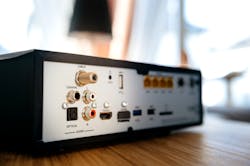Financial analysts have begun to question how long U.S. cable MSOs can dominate broadband subscriber market share when their telco competitors are hurriedly replacing xDSL links with fiber-based PON. After all, 10G PON technologies such as XGS-PON are commercially available to enable multi-gigabit services more easily than the DOCSIS 3.1 technology on which most cable MSO hybrid fiber/coax (HFC) networks operate today. Meanwhile, the DOCSIS 4.0 technology designed to bring capabilities comparable to 10G PON remains mostly in development. So it seems just a matter of time before telcos begin to catch up, such analysts reason.
It's certainly true that fiber to the home (FTTH) using 10G PON can provide symmetrical transmission capabilities that outstrip those of DOCSIS 3.1. However, some of these analysts may be overlooking two important points: 1) cable MSOs are increasing their own use of FTTH and 2) it’s looking like DOCSIS 4.0 may be easier to deploy than previously believed.
Footprint expansion
Ask pretty much any cable MSO planner and he or she will admit that the future is fiber, regardless of how much HFC infrastructure they’re currently using. Fiber is the de facto approach for greenfield applications for this reason.
Which is why cable MSOs are reporting significant increases in their FTTH deployments. For some, generally smaller operators, a “the future is now” approach has led them to decide to replace their HFC with FTTH. Western Pennsylvania’s Blue Ridge Communications provides one such example. The service provider will convert from DOCSIS 3.1 HFC to FTTH over 8000 miles of installed infrastructure that passes more than 250,000 homes.
Such overbuilding of an existing HFC network remains rare. However, several cable MSOs are taking the notion of using fiber in greenfield applications to new lengths as they seek to expand beyond their traditional footprints. For example, Breezeline (formerly Atlantic Broadband) has major FTTH initiatives underway to capture share in new markets in New Hampshire and West Virginia as part of an $82 million initiative to reach nearly 70,000 additional homes and businesses with fiber. The cable MSO also has a new FTTH build underway to reach 1,400 homes and businesses in the Virginia counties of Mathews, Caroline, Lancaster, and Middlesex.
In addition to bringing new competition to new markets, cable MSOs also are reacting to the same trends the financial analysts cite. Altice USA, for example, is seeing extensive competition from Verizon and AT&T fiber broadband and is fighting fire with fire. The cable MSO’s CEO, Dexter Goei, told attendees on the company’s first quarter 2022 earnings call that he expects Altice USA FTTH to pass 6.5 million residences by the end of 2025.
The move to fiber has more benefits than just getting on an equal footing with telco giants. “When comparing the experience of our broadband customers on our fiber network to that of customers on our HFC network, we are now seeing 66% NPS improvement, 7% higher ARPU on gross adds, and around 5% to 6% annualized churn benefits,” Goei stated on the call.
Standing their ground
Even the top three U.S. cable MSOs – Comcast, Charter Communications, and Cox Communications – have deployed fiber strategically for greenfield applications and in support of their business services offerings. Yet it is unlikely that we’ll see any of these three operators make FTTH the main focus of their broadband strategies in the near future.
The reason for their confidence in HFC was on display in May at a CableLabs-hosted 10G technology showcase. There, both Charter and Comcast showed off the capabilities of the two primary pathways to DOCSIS 4.0 – Extended Spectrum DOCSIS (ESD) and Full Duplex DOCSIS (FDX) – as well as surprising work from Comcast that showed FDX may be more easily deployable than previously believed.
Charter kicked off a demonstration for press and analysts with an ESD implementation that combined 1.8-GHz amplifiers in a Node+4 (meaning a node plus four amplifiers) cascade. Charter showed the ability to support 8.9 Gbps downstream and 6.2 Gbps upstream using 4K QAM modulation. John Williams, vice president of engineering at Charter, said the service provider believes it can employ ESD in links with a greater number of amplifiers, but that Node+4 is typical in Charter’s network.
Comcast was next up with a demonstration of FDX that leveraged the company’s virtual CMTS core. The demonstration highlighted the delivery of high-speed broadband (approximately 8.5 Gbps downstream and 5 Gbps upstream) via 2K QAM. A Comcast spokesman said 4K QAM capabilities will be coming in a few months.
However, prototype FDX amplifiers capable of enabling FDX transmission in Node+2 architectures raised eyebrows during the demonstration. Comcast will release more details of this work in the second half of this year. However, the operator is targeting the ability to support Node+6.
Common wisdom had suggested that FDX would require the removal of all amplifiers between the node and the subscriber. The ability to leave at least some amplifier sites in place – or not remove any at all – would make FDX a viable option for a wider number of cable MSOs.
It seems unlikely that significant deployments of DOCSIS 4.0 technology will become possible for another year or two. Nevertheless, the ability of cable operators to deliver multi-gig services now over DOCSIS 3.1 (although still lagging FTTH in terms of upstream capabilities) and keep approximate pace with 10G PON via DOCSIS 4.0 not too far down the road gives many MSOs confidence that a wholesale switch from HFC is unnecessary.
So FTTH will continue to be more ubiquitous among cable MSO infrastructure in the U.S. for several reasons. But it won’t supplant HFC in more than a handful of networks for the foreseeable future.
STEPHEN HARDY is editorial director of Lightwave.

